Thursday, December 3, 2009
Saturday, December 13, 2008
Mini Eggplant
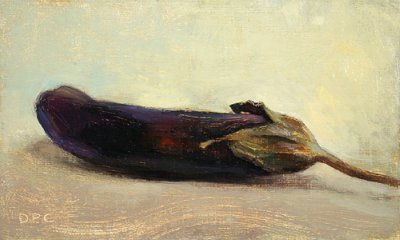
7/24. Mini Eggplant, oil on linen on panel, 3x5 in.
Another old one, out of order. I don't know why I didn't post these eggplant pictures. I really like this one—I think I was able to really stay connected and aware, or, I think the way my friend Gary once put it, to do the best painting I could at that particular moment.
Posted by
Dan P. Carr
at
9:05 PM
7
comments
![]()
Tags: daily painting, food
Eggplants
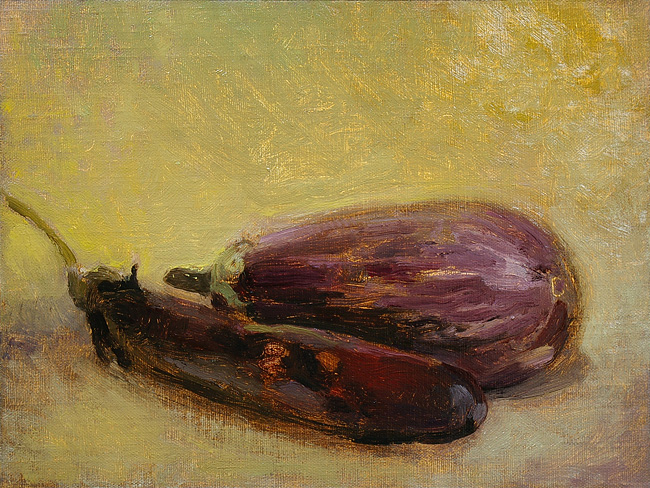
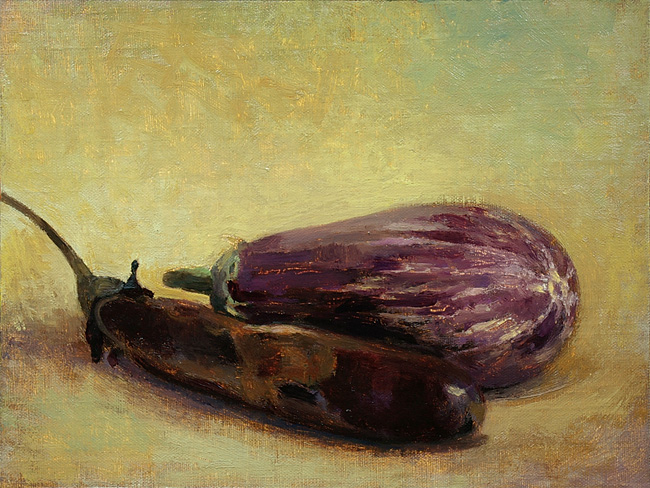

7/23. Eggplants, oil on linen on panel, 6x8 in.
A piece from way back in summer before the mango, done over several nights. (What I remember is,) the first night I couldn't really get into it, partly because the big eggplant had a coloring that was a cooler purple than the skinny one and that I had trouble zeroing in on; moreover, I couldn't figure out how to "draw" the complicated striping on the big eggplant.
On the big eggplant especially, I found myself going back and forth between rendering form (the dullish, even spread of light) and surface gloss (the clean, juicy shadow tones), which process was complicated again by the busy stripy pattern.
The second session was either the next night or two nights later, and the third session a few nights after that, so that the skinny eggplant (which was already getting mushy) had enough time to undergo some natural transformation. A few of these "changes" I left out because they were either difficult to add on top of what I had already painted or because they were simply very unappealing. My backdrop must not have been simple or solid enough because I played around with some different colors (blues, greys) and was unsure how to keep it.
At some point I had gotten a tube of aureolin (cobalt yellow) because Williamsburg and others mention its use "in some of Turner's skies." I had taken to using Indian yellow because of its transparency but wondered how the cooler aureolin would work (good enough for Turner!), so I tried some of it in the yellow background at the third stage. I found it to be much greener than I would have liked and spent a lot of time trying to undo the experiment (it's quite strong), perhaps overcorrecting towards the too-hot—and making another example of excessive chroma syndrome, or whatever they call it. I don't dislike it though; and as far as the baffling stripy pattern goes, I was satisfied enough with the somewhat impressionist treatment of it (good enough for me).
Posted by
Dan P. Carr
at
7:30 PM
8
comments
![]()
Tags: art supplies, daily painting, food, work in progress
Friday, November 7, 2008
Cream
"Lawdy Mama," 1967 (outtake from Disraeli Gears, later released on Live Cream). Jack Bruce, bass; Ginger Baker, drums; Eric Clapton, guitar and vocal.
So smooth. These guys truly were the cream of the crop, each complemented the others perfectly. I love this – the perfect vocal timing, the masterful strutting beat, but perhaps most of all Jack Bruce’s expert bass playing, which supports Clapton then subtly emerges at the surface in places with something unexpected. Functional, I suppose, but never pedestrian, though I’m no expert (and yet arguably there were some cases, e.g. the famous live "Crossroads," where Bruce outplayed Clapton).
If you are somewhat familiar with Cream you may notice the similarity here to the song "Strange Brew": their producer, wanting something more trippy and pop than a white-man’s-blues rendition, put a new vocal and guitar track from Clapton over the existing bass and drum parts. From what I gather Bruce wasn’t around to supply a revised bassline and was unhappy (understandably?) with the result.
I don't know what the equivalents in painting would be to the layers in a musical piece, but I think of a great bassline as something like the imprimatura or primuersel that shows through in a painting, whether visible in transparent passages or in parts left exposed outright (see Rembrandt). In the best cases it doesn't immediately jump out and smack you in the face.
[Credit to the original posters.]
Posted by
Dan P. Carr
at
8:36 PM
2
comments
![]()
Tags: miscellanea, music, videos
Tuesday, November 4, 2008
Friday, October 3, 2008
A Lightfast Alizarin
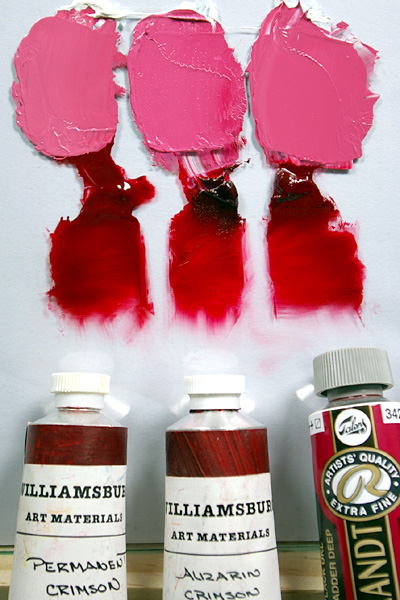
I finally decided to replace my Alizarin Crimson, which is only moderately lightfast (not that I ever really use it by itself in thin layers). I love the Alizarin by Williamsburg (dihydroxyanthraquinone, PR 83) and wanted to give their substitute a chance as I now go with them for all but one of my palette colors, so I tried their Permanent Crimson (anthraquinone, PR 177), which is described as an "absolutely permanent, lightfast substitute for Alizarin Crimson." Very disappointingly, Gamblin's Alizarin Permanent is made from a mixture of quinacridone red b (PV 19), perylene red (PR 149), and ultramarine (PB 29), so I'm not bothering with that. I read recently in at least three places that a truer substitute for the traditional Alizarin or madder hue is pyrrole ruby pigment (PR 264), which can be found in Rembrandt's Permanent Madder Deep (among others), so I got a tube to check it out.
Here I mixed a tint of each one with titanium white. I was afraid a photo would flatten any hue difference between the pigments, but except for the Permanent Crimson which seemed the tiniest bit warmer (this would create slightly less purple purples if you know what I mean), there was little hue difference for the camera to flatten. And all three pigments are strong-staining and have that lovely pinkish undertone. In masstone, however, the substitutes clearly don't match the Alizarin, in center, which is beautifully deep and dark as a thick pile (it almost resembles here a bleeding scab). The substitute Williamsburg, at left, feels flat, with little difference between its masstone and undertone. The Rembrandt pigment, while not an exact match, shows at least some of that Alizarin-like deepening as it gets thicker. Such deepness might not factor much in my normal painting work but it was something I was happy to see, so for this along with its excellent berry-juice-like quality overall, I'm going to try using the Permanent Madder Deep as my Alizarin substitute.
Posted by
Dan P. Carr
at
1:46 AM
6
comments
![]()
Tags: materials, miscellanea, palette
Thursday, October 2, 2008
"The Exquisite Still Life" show, Salem, Oregon
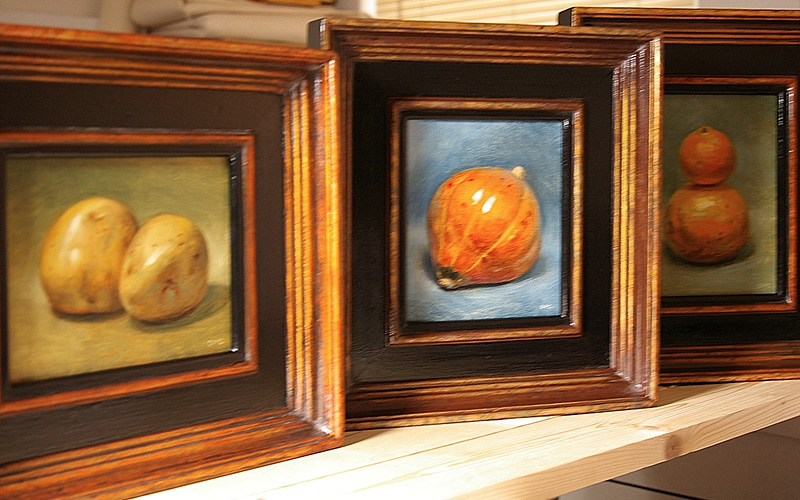
The other day I sent out nine pieces for an exhibit titled "The Exquisite Still Life" at Chemeketa Community College in Salem, Oregon. Also showing will be Oregon painters Lisa Caballero, Bobbie Jansen and John Van Dreal, so I was surprised and delighted when asked several months ago to participate, being all the way out here on the opposite coast. The show starts this coming Monday the 6th and runs through the 31st, with a reception on Wednesday the 8th from noon to 2 pm. If you live in the area please come.
Posted by
Dan P. Carr
at
10:03 PM
9
comments
![]()
Tags: miscellanea, shows
Wednesday, September 10, 2008
Mango #2, and Color in Old English (Part 3)
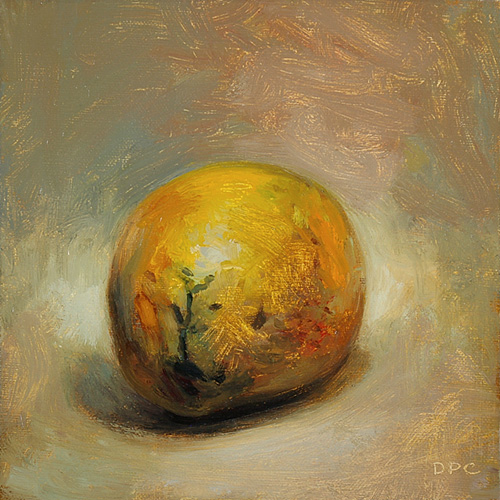
7/30. Mango #2, oil on linen panel, 5x5 in. SOLD
I had long wondered what was meant by "red gold" in medieval literature. Was it, like so-called red or rose gold today, simply a colored gold alloy? If not, why was it called red? Of course, the answer to this might have to do with what the color "red" once meant.
A cursory explanation was offered by Nigel Barley in "Old English Colour Classification" (Anglo-Saxon England 3, 1974). His theory of Old English colors states that they were centered on a light-dark axis, and that a few colors had derived from ancient horse color terms (which Earl Anderson would later elaborate upon) - these special colors were normally used of "animate" things, or else to describe some other-dimensional aspect of an object's surface. But despite this over-ruling ancient "binary opposition" of light and dark, hues sometimes were distinguished, even if, on the hue axis, the Old English colors didn't line up with our modern color system. Barley gives a table, like the one below, that shows "how simple is the solution to that most perennial of old disputes in Anglo-Saxon - the use of read to describe gold" - we see that the Old English colors read and geolo once lay in different places on the spectrum from those of modern English "red" and "yellow":
..Modern English....Old English
.________________ ________________
(................!................)
(......blue......!................)
(................!.....hæwen*.....)
(————————————————!................)
(................!................)
(.....purple.....!————————————————)
(................!................)
(————————————————!.....baso*......)
(................!................)
(......red.......!————————————————)
(................!................)
(————————————————!.....read.......)
(................!................)
(................!————————————————)
(.....yellow.....!................)
(................!.....geolo......)
(................!................)
(————————————————!————————————————)
(................!................)
(.....green......!.....grene......)
(________________!________________)
*Hæwen and baso were not basic-level color words.
Barley writes, "Recourse is often had to highly ingenious and learned explanations urging that gold in medieval times had a relatively higher copper content and that it was consequently redder than modern gold. We are told that the adjective was used only for the alliteration or because it had become a set phrase. As elsewhere, such explanations lack an anthropological perspective and so fail to realize that Old English 'red' is not our red and that we cannot blandly equate the two categories." While Barley's explanation considers the "variation from culture to culture in the position of boundaries," Earl Anderson suggests we also determine the possible focal point of the color red in Old English. He writes,
"Contributing to the reputation of 'red' as the color par excellence is the extraordinary stability of *rudhró- (together with its northwest variant *rowdhó-) in the Indo-European languages," he says; *rudhró- possibly is a loanword from Sumerian urudu 'copper' from Sumerian *burudu, "which gave the Euphrates river its ancient name[.]" The connection to copper or ore can be found in Latin raudus, pl. rudera "piece of copper, copper coin," Russian ruda "ore." *Rudhró- is found in the Greek erythros and Latin ruber. The variant *rowdhó- appears in Baltic, Celtic, and Germanic languages, e.g. Lithuanian raudas, Old Irish ruad, Welsh rhudd, Old Norse rauðr, and Old English read (and noun rudu "redness").The virtual universality of 'red' as a semantic category is a linguistic by-product of the artistic and ritual use of ocher among primeval human cultures the world over. Ocher is a clayish soil containing hydrated oxide of iron, with colors that include yellows, reds, and browns. Iron ore is found also is found in the purer forms of red hematite and yellow-brown limonite. Ocher, hematite and limonite in pulverized form often were used as pigments by ancient man. The colors of these ores can be intensified and darkened by heating them and by mixing them with water or with some other liquid.... The material culture, ... considering the early importance of ocher in it, may very well be the motivator of 'red' as a basic color term in languages around the world.
Anderson goes on, "In the Iliad, [erythros] is used for the color of copper as well as of blood, wine, and nectar.... For speakers of contemporary European languages, 'red' has its focal point in the color of fresh blood. We should take care, however, not to project this intuitive knowledge of red onto languages other than our own, for blood, copper and ocher all are possible candidates as the material basis of red." So red might have been more earthy than we are used to today (and possibly why Aristotle was against describing the dawn as erythros). The problem of "red gold" is made more puzzling, says Anderson, by the fact that "gold" (Germanic *gelto-) was derived from "yellow" (*gelwoz), but that it is
modified by 'red,' not by 'yellow' until later medieval times. [The 14th-century poem Wynnere and Wastoure has the phrase ȝalowe golde.] This certainly differs from the situation in the sixteenth century, when Thomas Cooper (1578) defined the verb flaveo, 'to be yelow, or of colour lyke golde,' and ... when Samuel Johnson, in his Dictionary (1755), defines ruddy as 'Approaching to redness,' and then gives, as a second meaning, 'Yellow. Used, if at all, only in poetry.' Johnson was thinking of Dryden's line, 'A crown of ruddy gold inclosed her brow,' a relic reminiscent of the Old an Middle English ways of describing gold, which by the eighteenth century had become forgotten to the extent that he didn't know what to make of it.
The modifying phrases used in Old Norse are raut gull 'red gold' and bleikt gull 'bright gold' (cf. OE blac [easily confused with blæc "black"]); Old Norse also has raud mani 'red moon' and et rauða 'egg yolk.' Among the twenty-eight times that read- is used in Old English poetry, the phrase read gold appears four times. Read- modifies gold about twenty-one times in the Old English corpus, and it modifies blod about twelve times.... Among the fifty-four times that rot 'red' appears as the most frequent color word in the Middle High German Nibelungenlied, eighteen times it modifies golt.
Anderson discusses the proposed solutions to this puzzle:
(1) The meaning of "red" was indeterminate. Some in the 19th century believed that primitive Germanic peoples had an underdeveloped capacity to see color, hence "red" could be used to describe gold. But this doesn't explain why gold could not also have been described as "yellow."
(2) "Red gold" was merely a poetic convention. This theory, mentioned by Barley above, was just an extension of another 19th-century idea that the severely limited palette of the Iliad and Odyssey was a stylistic choice. "It is true that read gold is a verse formula, always appearing as a b-verse in Old English poetry; but beyond the poetry, read modifies gold sixteen times in prose or in glosses ... [and those examples] are not confined to any one formula. Moreover, the phrase 'red gold' continues to be used in Middle and early modern English, long after the potential influence of oral poetic tradition."
(3) Also mentioned by Barley is the theory that the gold of the Middle Ages "was often darker than that of our own, and contained a considerable alloy of copper," as W.E. Mead wrote ("Color in Old English Poetry," 1899). Anderson says that gold objects from medieval China do tend to have a reddish color, and that in Europe, since the time of the late Roman Empire, "the gold used in coinage often was alloyed with copper, but this was not normal practice for gold used in manuscript illustrations and for jewelry or precious objects." Although Anglo-Saxons only rarely used gold in manuscript illustration before 900, "[later] artists sometimes used it generously, and when they did, they used highly burnished gold, not only for incidental details, in a picture, but non-naturalistically to sectionalize or unify or frame a picture, and to brighten it." And while an inventory of Anglo-Saxon metalwork would indicate a number of gold-copper alloy objects, Anderson believes that
(4) L.D. Lerner, in "Colour Words in Anglo-Saxon" (Modern Language Review 46, 1951), had said that read was one of several color words (including brun, græg, and fealo) relating to brightness (or shininess?) rather than hue - so that read gold really meant "bright gold." This was just a revival of the theory that primitive peoples had a limited "color sense," and of theories like Mead's which describe an ancient preoccupation with light-dark contrasts - so that hwit often meant "bright" instead of "white"; brun when applied to metal meant "bright" with, as Mead says, "a suggestion of redness"; fealo of weapons meant "bright" and slightly yellow; etc. Barley argues the same point when he writes that the color system stressed brightness over hue. But, says Anderson,the Anglo-Saxons were more likely to safeguard the integrity of gold because of its greater value. In some prose texts, indeed, read as a color-modifier suggests the purity and brilliance of gold rather than its adulteration with base metals. This is the case with an anonymous homily De sanctio Iohanne:
Þu gelitenest swa read gold, ealra fugela king, Fenix gehaten
[You shine like red gold, king of all birds, called Phoenix]... and again [in Ælfric's Catholic Homilies I] when St. John transforms a bunch of green branches into golden rods:
ealle þas goldsmiðas secgað þæt hi næfre ær swa clæne gold ne swa read ne gesawon
[all the godsmiths say that they never before had seen gold so pure and so red]
However this may be, the range of referents modified by read in Old English is such that the word in itself could hardly imply 'brightness,' although it is true that bright things, like the sun or the sky or gold, and maybe even blood and wind, could be red. Among the items often described as read in charters are topographic features such as rocks or stones, especially boundary stones (17 occurrences), cliffs (7), ditches (8), a ridge (2), a path or road (14), a slough or wallow (7), a spring (5), stream (6), ford (7), or pool (3). Read, when applied to these referents, evokes an earthen or mineral color.(5) Barley's solution, as we saw above, was that the places "red" and "yellow" occupied on the color spectrum were different from where we would put them today, so that gold was called read and not geolo.
(6) Another possible solution is the theory that
'red,' the color par excellence, has a close semantic association with 'color' in the sense of a 'covering,' exemplified by gilt, paint, or, in paleolithic and neolithic times, by fine red ocher dust sprinkled over a body in a funeral. In the phrase read gold, the essential idea is that gold is a covering; its chromatic value is secondary. For this reason, 'red' is preferred to 'yellow' as a modifier for gold ... In some languages, it is true, the taxonym for 'color' also means 'red': ... [e.g] Spanish colorado 'reddish.' In ancient and medieval Europe, red was a symbol in malo of evil, of the devil, and of a dreadful disease called "St. Anthony's fire" in the Middle Ages and Renaissance ... whereas in bono, red had protective power against evil.... According to this line of reasoning, red, as the color of blood, has a special association with sorcery or magic or the supernatural or the universal life-force and thus could extend to gold, the best of all metals.But, although English "color" was a loanword from Latin color (rooted in celare 'to conceal'), the "closest semantic counterpart to color in Old English ... is hiw, which means 'color,' 'shape,' or 'appearance' but not 'covering.'" And with regard to magic or a universal life-force, Anderson says
the symbolic role of blood is ambiguous in medieval iconography. The wine ceremoniously consumed at communion symbolizes and becomes Christ's blood, shed at the time of the crucifixion as the basis of mankind's salvation. On the other hand, it is a medieval scientific commonplace concerning the blood of animals that 'heora blod is heora lif' [their blood is their life (Ælfric's Catholic Homilies I)], in contrast to human beings, for whom life consists in the soul rather than in blood. There is, after all, then, no particular connection between 'red' and sorcery or the supernatural in Old English.
Of these six possible solutions to "red gold," Anderson says that Nigel Barley "is right if all he means to say is that the Anglo-Saxons thought of gold as read rather than geolo." Anderson suggests a "larger theory," that
Anderson notes that information about relative frequency doesn't say much about the focality of read, but rather the subject matter of the material in which we find the word: the read paths and boundary stones mentioned in charters, the colors used in scientific texts, and the many references to the Red Sea in religious works are all "out of proportion to the probable use of read in the ordinary speech of the Anglo-Saxons. With respect to semantic range, however, [this information] encourages the belief that 'earth tones' are a canonical part of read."Old English read and its early Germanic cognates preserved the semantic range of Indo-European *rudhró: the colors obtainable through the artistic preparation of ocher and hematite: red, reddish brown, orange, and reddish yellow. The reason for 'red gold' rather than 'yellow gold' is, quite simply, that read is mainly earthen, mineral, or metallic in its focus, whereas geolo focuses mainly on the colors of vegetation, and resembles grene in this respect.
The conceptual challenge that 'red gold' offers has two parts: the semantic range of 'red' is comparatively restricted compared to Old English read. 'Orange,' 'pink,' 'purple,' and 'gold' are basic colors in contemporary English, and thus are sharply differentiated from 'red.' In Old English, in contrast, these colors belong to the semantic range of read.... Leaving aside the biblical hydronym read sæ [Red Sea] which is just a translation of Mare rubum, the most frequent referents are topographic features such as cliffs, rocks, ridges and paths, streams, ditches, pools, mires and wallows, and herbs and nettles. The referents include blood, apples, peppers, grapes, clover, lips, the uvula, bodily wounds, and, of course, gold.
In modern English, as noted earlier, the focal point of 'red' is something like the color of fresh blood, therefore we may tend to think that blood was the prototypical referent of 'red.'
It is quite possible, however, that the prototypical referent of the Indo-European word for 'red' was ocher, the earliest mineral-based pigment to be used universally by mankind. OE read was, in other words, essentially an earthen color, at least originally. The possible focal points include reddish brown, orange, and reddish yellow; the bright red of fresh blood is possible but improbable. At some early point in their history, the Indo-Europeans learned the use of copper as it spread from Sumer to other parts of the Fertile Crescent and beyond, and at that time, ocher may have been displaced by copper as the focal point of 'red'; this new foreign influence on the material culture may have found expression, as well, in *rudhró- based on the same root as Sumerian urud 'copper.' No doubt the focal point and range of this word varied in time and place among Indo-European dialects, affected by changes in the material culture such as the introduction of shellfish or plant-based dyes and advances in medical and metallurgical technologies. It is impossible to prove that the focal point of OE read was something other than the color of blood, but two arguments favor this position:
(1) Of more than 260 appearances of blod- in Old English texts, it is called read fourteen times, and once rudig. Read is the color word most often used to modify blod, but fah~gefah, and sweart are also used....
(2) In the Old English Lapidary ... periphrastic descriptions of the blood-like colors of sardonyx [blode licost "most like blood"] and sard [luttran blode gelic "like clear blood"] are used, rather than read. If fresh blood were the prototypical referent of Old English read, one might have expected a phrase like *read blode gelicost, or possibly blodread which appears four times in Old English ...
These arguments are inconclusive, at best suggesting that we cannot draw firm conclusions about the focal point of OE read. It is possible that read has two focal points, one the color of freshly drawn blood, and the other a mineral color like gold - just as modern English blue has two focal points. We cannot be certain about that, but we can be certain that read was a basic color word whose semantic range included red, orange, pink, gold, and purple.
Posted by
Dan P. Carr
at
11:37 PM
1 comments
![]()
Tags: books, daily painting, food, history, Middle English, Old English, poetry, translation, words
Saturday, September 6, 2008
Williamsburg Paints on eBay!
For anyone who is interested, I got a bunch of Williamsburgs recently at a great price and have just put them on eBay. Click on the big fancy sidebar link!
Posted by
Dan P. Carr
at
12:16 AM
2
comments
![]()
Tags: miscellanea
Wednesday, September 3, 2008
Color in Old English (Part 2)
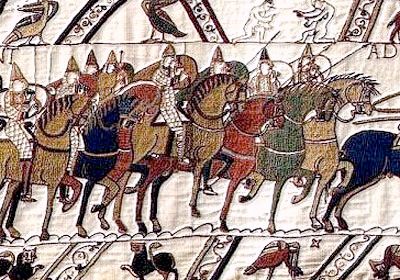
hiw - shape, appearance, as well as colorbleo - complexion, appearance, and form as well as colorfah - stained, guilty, criminal, shining, and variegated as well as colored
Is se fugel fæger__forweard hiwe,
bleobrydgum fag__ymb þa breost foran.[The beautiful bird is foremost in color (or: appearance or shape), colored (or: adorned) with variegated colors in front, around his breast.]"
So, what about the actual color names themselves? After exhaustive reconstructions of the color taxonomies of Proto-Indo-European, Greek, Latin, and Germanic, Anderson concludes that Old English had (like Germanic) six basic color terms:
BLACK - sweart, with the innovation of blæc as a rival synonymWHITE - hwit
RED - read
GREEN - grene
YELLOW - geoloGRAY - græg
It is a misconception widely held that cross-linguistic variation in color vocabularies results from differences in the ways 'color space' is divided from one language to another. The chromatic spectrum, according to this view, is a continuum without breaks, but languages use basic color words to divide up the spectrum in different ways. If this were so, we should expect speakers of a given language to agree as to the 'boundaries' between one color and another. This was not the case, however, in tests in which speakers of American English and Dani were asked to identify an assortment of color chips as exemplifying one color or another. Neither the Americans nor the Dani could agree among themselves as to the boundaries between yellow and green or green and blue [Eleanor Heider, "Universals in Color Naming and Memory," Journal of Experimental Psychology 93, 1972]. This leads to the conclusion that the boundaries between one color and another are idiolectic [different from person to person]. As Mead observed seventy years earlier, 'Most of us have a very limited color vocabulary, and we differ hopelessly in our terminology as soon as we move away from a few sharply defined colors[.]'
What Mead was getting at [in saying "we differ hopelessly in our terminology"], putting his native speaker intuition to good use, was the primacy of color focalities rather than color boundaries. The notion of color vocabulary as the arbitrary division of color space is disconfirmed by our own experiences.
... [F]or any given language, native speakers agree on the names and focal points of canonical colors. The hypothesis of focal colors was tested by Heider ... who, in the series of experiments alluded to earlier consulted twenty speakers of American English, and twenty-one speakers of Dani, a language that has only two basic color terms, mili for 'brightness' and for 'warm' colors and mola for 'darkness' and for 'cold colors' ... In one experiment, English and Dani informants were presented with color chips that exemplified both saturated or 'pure' colors and unsaturated colors, and were asked to recall the colors. In another, the Dani were asked to learn names for both saturated and unsaturated colors. In these tests, ... both Dani and English speakers named the saturated colors more rapidly, and gave these colors shorter names, compared with nonsaturated colors. Select saturated colors, therefore, are marked as 'focal,' and their focality influences cognition, for Dani speakers as well as for speakers of English, even though Dani has no chromatic color terms.
"It is natural to think of erythros, the basic term for 'red,' as occupying a large semantic space in which phoinikos and rhodos are located as smaller spaces. We would probably want to think of the relationships among modern English terms for 'red' in the same way ...":
'rosy-fingered dawn,' based on the verse formula rhodo-daktylos eos in the Iliad.... In a discussion of diction as an aspect of style, Aristotle notes his disagreement with the sophist Bryson, who says that there is no such thing as bad word choice because one synonym will do as well as another in cases where words have the same referent. Aristotle argues the contrary ... In the case of metaphor, well chosen words are
beautiful to the ear, to the understanding, to the eye or some other physical sense. It is better to say, for instance, 'rosy-fingered morn' (rhodo-daktylos eos) than 'crimson-fingered' (phoiniko-daktylos), or, worse still, 'red-fingered morn' (erythro-daktylos).
One could argue Aristotle was only thinking of the sound of the words [that is, that rhodo-, already part of a Homeric verse formula, was better for having only two syllables and not three like phoiniko- or erythro-] ... But this does not explain why Aristotle regards erythro- as the ugliest of all possible substitutions that he can think of, and this should give us pause, for Aristotle is a reliable witness, and erythros is the basic color term for 'red.' Come to think of it, whenever Aristotle, in Meteorologica, has occasion to refer to redness in the sky, he avoids erythros, using specialized terms such as phoinikos or porphyrios ... and he avoids metaphorically-derived terms such as aimatode chromata (blood-(red) colors) ... For Aristotle, erythros was not a color term that one used in a meteorological context, and for this reason, 'red-fingered dawn' was not available as a possible substitution for 'rosy-fingered dawn.' ... In their analyses of rainbow colors [which is a whole other discussion], Aristotle and Xenophon use phoinikos but not erythros, although a century after Aristotle (c. 260 B.C.), Poseidonios uses both phoinikos and erythros. Perhaps erythros in earlier Greek was focalized on a mineral color, like that of red bricks or iron ore or ocher. Whatever the precise solution to this problem might be, Aristotle's discussion of 'rosy-fingered dawn' illustrates that basic color terms must be thought of in terms of focalities; 'red' is not a genus that incorporates all supposed hyponyms.
These specialized terms are the crux of another puzzle, from the Old English Prognostics - "where the writer interprets the meaning of dreams about horses of different colors:
Gyf mon mete þæt he hwit hors hæbbe oððe on ride, þe byð weorðmynd.Gyf him þince þæt he on blacum horse ride, þe byð his modes angnes.Gyf him þince þæt he on readum horse ride, þe byð his goda wanigend.Gyf him þince þæt he on fealawan horse ride, þæt byð god, oððe grægan, þæt byð god swefn.[If someone dreams that he owns a white horse or rides on one, that means honor. If it seems to him that he rides on a black horse, that is anxiety of mind. If it seems to him that he rides on a red horse, that is waning of his property. If it seems to him that he rides on a fallow horse, that is good, or a gray one, that is a good dream.]"
An attempt to match up the two groups of color words does not work:
Latin ......Old Englishalbus.......hwitniger.......blacumbaiuscastaneus...readumflavus......fealawan............grægan
The approximately 152 horses in the tapestry are all monochromatic, in five hues that range from light golden yellow to blackish brown, representing Old French sorel 'golden yellow,' fauve 'brownish yellow' (cognate of OE fealu), ferrant (from Latin ferron) 'iron gray' with a blue coloration, bai (from Latin badius) or baïart 'reddish brown,' and noiron 'blackish brown.' These colors are used, as well, as the proper names of horses: Sorel, Fauvel, Ferrant, Baiard, and Noiron. In several tapestry scenes, horses in groups of four are differentiated from each other by colors and in these cases the colors usually are sorel, fauve, bai, and noiron. A horse ferrant is seen less often, and then as part of a pair, partnered with either sorel or fauve. Color terms are used in Old French, then, as in Old English, to classify horses, not merely to describe them, and the semantic influence of French color-classifiers is so strong that it gives rise to the proper names of horses and it allows for the non-realistic coloring of horses in the Bayeux Tapestry.
Posted by
Dan P. Carr
at
2:46 PM
0
comments
![]()
Tags: books, history, Middle English, miscellanea, Old English, poetry, translation, words



